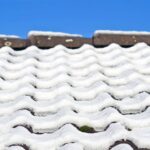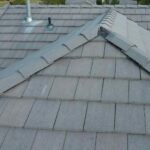
EPDM rubber roofing has become one of the most popular choices for flat and low-slope roofs in Lakewood, CO. This synthetic rubber roofing membrane offers several advantages that make it an ideal choice for both residential and commercial properties.
In this ultimate guide, we will discuss the top five advantages of EPDM rubber roofing and why it is an ideal choice for your roofing needs.
What is EPDM Rubber Roofing?
EPDM rubber roofing is a type of roofing material made from ethylene propylene diene monomer (EPDM), a synthetic rubber. EPDM is a flexible material that is resistant to weathering, chemicals, and UV rays. It is also a good insulator, which can help to reduce energy costs. EPDM roofing is often used on commercial and industrial buildings, but it can also be used on low-slope residential roofs or flat dormer roofs.
Lakewood Roofers Providing Top-notch Roofing Services

Benefits of EPDM Rubber Roofing
EPDM membrane is a time-tested roofing option that has been widely used in the roofing industry since the 1960’s due to its durability, affordability, and flexibility. This material has a life expectancy of up to 50 years, making it a long-term investment for your property. Here are some of the advantages of EPDM roofing:

- Enhanced durability: EPDM is designed to be highly durable and have a long lifespan. It can withstand extreme weather conditions, such as heavy snowfall, hail, high winds, and intense ultraviolet (UV) radiation. These attributes make it an ideal roofing material for the harsh climate of Lakewood Colorado. It also has great resistance to temperature fluctuations, being able to handle extreme temperatures, from hot to cold, without significant degradation.
- Flexibility: Because it elastic and highly flexible, EPDM roofs can accommodate building movements and settling without cracking or tearing. It is also great for areas that get a lot of snow as it can freeze and thaw without getting damaged.
- Low maintenance: This rubber roofing requires minimal maintenance. It is resistant to mold, mildew, and algae growth, reducing the need for regular cleaning. Periodic inspections and basic maintenance, such as removing debris and ensuring proper drainage, are usually sufficient to keep the roof in good condition.
- Leak resistance: EPDM membranes have excellent waterproofing properties. The rubber membrane forms a seamless barrier that prevents water penetration, reducing the risk of leaks. Proper installation and regular inspections can help maintain the roof’s integrity and further minimize the chances of leaks.
- Energy efficiency: Because of its great insulating properties, EPDM roofing help reduce heating and cooling costs. It reflects heat from the sun, reducing the heat load on the building and keeping interior spaces cooler. Additionally, it can be combined with insulation materials to enhance energy efficiency further.
- Easy installation: It is relatively easy to install, especially for flat or low-slope roofs. It can be adhered, mechanically fastened, or ballasted depending on the specific requirements of the project. The installation process is generally quicker compared to other roofing systems, which can help save time and labor costs.
- Affordable: EPDM roofing is often considered a cost-effective roofing option. Its durability and long lifespan mean that it can provide reliable protection for many years, reducing the need for frequent repairs or replacements. The material itself is relatively inexpensive, and its installation costs are generally lower than those of other roofing materials, such as TPO (thermoplastic olefin) or PVC (polyvinyl chloride).
- Environmentally friendly: EPDM is considered environmentally friendly due to its energy-saving properties and recyclability. EPDM can be recycled at the end of its life and used in the production of new materials, reducing waste and environmental impact.
EPDM Rubber Roofing Installation Process
EPDM rubber roofing installation is a simple and straightforward process that can be done by a professional roofing contractor or by yourself if you have the right tools, experience, and skills. The first step in the installation process is to prepare the roof surface by cleaning it thoroughly and removing any debris or existing roofing material. Once the surface is clean and dry, the EPDM rubber roofing can be laid out and cut to fit the roof dimensions.
After the EPDM rubber roofing has been cut to size, it can be secured to the roof using adhesive or mechanical fasteners. The seams between the EPDM rubber roofing sheets can be sealed using a special adhesive tape or liquid adhesive. Once the roofing is in place, it can be trimmed and finished with flashing, gutters, and other accessories.
Hiring Skilled Roofing Contractors in Lakewood, CO
If you’re not that experienced with the material and the installation process in general, hiring a professional contractor for EPDM roofing installation is highly recommended due to the specialized knowledge, expertise, and experience they bring to the table.
EPDM roofing requires precise installation techniques to ensure its effectiveness, longevity, and proper performance. Entrusting the job to a professional offers several significant advantages:
- Expertise: Professional contractors have in-depth knowledge and training in EPDM roofing systems. They understand the intricacies involved in the installation process, including surface preparation, proper adhesive application, seam sealing, and flashing details. Their expertise ensures that the installation is done correctly, minimizing the risk of potential issues or premature failure.
- Quality Workmanship: Professionals are equipped with the necessary tools, equipment, and techniques to deliver high-quality workmanship. They follow industry best practices and standards to ensure that your EPDM roofing is installed to the highest standards, providing a reliable and long-lasting solution.
- Time and Cost Efficiency: Hiring a professional can save you time and money in the long run. They have the experience and efficiency to complete the installation promptly and efficiently. DIY attempts may result in costly mistakes or rework, while professionals can get the job done right the first time, reducing the likelihood of future repairs or replacements.
- Safety Considerations: EPDM roofing installation involves working at heights, handling specialized tools and materials, and adhering to safety protocols. Professional contractors are trained in safety procedures, have the necessary safety equipment, and understand how to minimize risks during the installation process, ensuring the safety of both themselves and your property.
- Access to Quality Materials: Professional contractors have access to high-quality EPDM roofing materials from reputable suppliers. They can guide you in selecting the right type and thickness of EPDM membrane, as well as other necessary components, to meet the specific requirements of your project.
- Warranty Coverage: Many professional contractors offer warranties on their workmanship and the EPDM roofing materials they install. This provides you with added peace of mind, as any potential issues or defects can be addressed without additional costs, within the warranty period.
Maintenance and Repair of EPDM Rubber Roofing
One of the benefits of EPDM rubber roofing is its low maintenance requirements. However, regular inspections and maintenance can help extend the life of your roof and prevent costly repairs. It is recommended to inspect your EPDM rubber roofing twice a year, in the spring and fall, to check for any signs of damage or wear.
If you do notice any damage or leaks in your EPDM rubber roofing, it is important to repair them as soon as possible to prevent further damage. Small tears or punctures can be repaired using a patch kit and adhesive, while larger areas of damage may require a professional repair or replacement.
Cost Comparison of EPDM with Other Roofing Materials
EPDM rubber roofing is one of the most cost-effective roofing materials available, especially for low-slope roofs. Compared to other roofing membranes for flat roofs, such as TPO and PVC, EPDM rubber roofing is much more affordable, which makes it great for property-owners on a budget.
EPDM Roofing
- Cost: More affordable
- Installation: Flexible installation methods
- Durability: Resistant to UV radiation and weathering
- Lifespan: around 30-50 years
TPO Roofing
- Cost: More expensive than EPDM
- Installation: Heat-welded seams for a continuous membrane
- Durability: Resistant to UV radiation and punctures
- Lifespan: around 20-30 years
PVC Roofing
- Cost: More expensive than EPDM and TPO
- Installation: Heat-welded seams for a seamless membrane
- Durability: Excellent resistance to UV radiation and chemicals
- Lifespan: around 20-30 years
Frequently asked questions about EPDM rubber roofing
Q: How long does EPDM rubber roofing last?
A: EPDM rubber roofing can last up to 50 years with proper maintenance and care.
Q: Is EPDM rubber roofing environmentally friendly?
Yes, EPDM rubber roofing is made from recycled materials and is fully recyclable at the end of its life.
Q: Can EPDM rubber roofing be repaired?
A: Yes, small tears or punctures can be repaired using a patch kit and adhesive, while larger areas of damage may require a professional repair or replacement.
Q: Is EPDM rubber roofing easy to install?
Yes, EPDM rubber roofing is lightweight and easy to handle, which makes it a great choice for cost-effective installation and for installers who need to work quickly and efficiently.
EPDM rubber roofing for your Lakewood Roof
In conclusion, EPDM rubber roofing provides a variety of significant benefits for flat roofs. It is an attractive option for both residential and commercial applications due to its affordability, durability, and straightforward installation. Homeowners can also opt to use EPDM for flat dormer or garage roofs for their properties.
EPDM roofs offer dependable weather protection from the elements as well as high resistance to UV radiation and extreme temperatures. Additionally, their ease of maintenance adds to its appeal and enables building owners and homeowners to benefit from dependable and trouble-free roofing solutions.
Latest Posts
Related: commercial rubber roofing material, tpo rubber roofing, epdm ethylene propylene diene monomer, epdm roof installation, epdm roof maintenance, lowe’s rubber roofing



